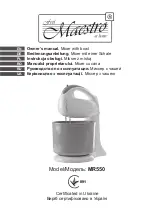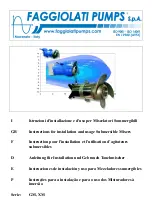
Operating Concepts & Terminology
Clarity
Operator Manual
Page 202
39
Operating Concepts and Terminology
39.1
OVERVIEW
The operation of Clarity is easily understood when you know the meaning of certain key terms
that are frequently used by Clarity. These terms have been adopted by LSC as the best
descriptions for functions and operations performed on Clarity
and may not be terms adopted
on similar equipment. These key terms are printed in underlined text below.
39.2
PROGRAMMER / PLAYBACK
Clarity uses a programmer and playback method of controlling fixtures.
In a programmer, you create lighting looks and record them as cues in a cue-list.
In a playback, you playback the cue-list.
There are many options available for you to choose what is recorded in each cue as well as how
each cue-list is played back.
Clarity is, by default, a tracking controller which means that Clarity usually only records and
plays back the
changes
that you make between each cue that you record.
You can also choose to record everything that is grabbed in the programmer (not just the
changes since the last recording) and to playback cues that include the entire look. This is
known as cue only playback mode.
The various options are described below.
See also the Record and Control Booth sections for more details on tracking and cue only.
39.3
PRIORITY CONTROL
Fixtures have attributes (intensity, pan, tilt, colour etc) and Clarity controls those attributes by
outputting values on the DMX slot associated with each attribute.
Attributes can be controlled by many different sources from within Clarity. The source of control
could be a programmer, a playback (of which there are many), or possibly no source is
currently controlling an attribute. When multiple sources are attempting to control an attribute,
Clarity uses a priority system to determine which source has control. A higher priority source
will override a lower priority on the output.
The priority order is:
Grand Master and DBO (Dead Black Out) control intensity only.
Highlight function.
Programmers.
Playbacks.
In addition to this priority order, individual playbacks operate on the LTP (Latest Take
Precedence) principle. The latest cue to be played back will output its attribute values and will
override any previous playback that contained the same attributes. (The priority of each cue-
list can also be manually altered if required).
39.4
ATTRIBUTE DEFAULT VALUES
When an attribute is not under control of a programmer or playback, Clarity's DMX output for
that attribute will be its
default
values contained in Clarity's fixture library. These values differ
for each type of fixture but typically will have the intensity attribute set to zero, pan and tilt set
to mid range and other attributes set to obtain an open clear beam.
You can set your own default values if you desire. Select the fixture(s) in programmer and set
desired values. Click
Menu
and select
Set defaults
. The default values are stored against the
fixture type, not per individual fixture. Only altered parameters will have their default values
changed.
Any changes that you make can be restored to the default values held in the fixture library.
Select the fixture(s) in programmer then click
Menu
and select
Reset defaults
.
39.5
PROGRAMMER CONTROL
When a fixture attribute is controlled by a programmer, the attribute is said to have been
grabbed by the programmer (indicated by an * beside its name in the selection side bar). If the
programmer is used to vary the value of the attribute, the attribute is said to have been
touched by the programmer. If the touched value is recorded into a cue-list, then that the
















































